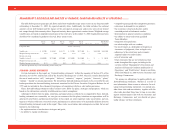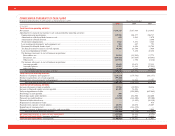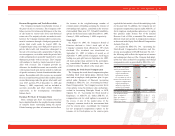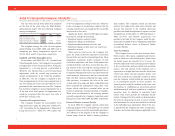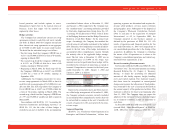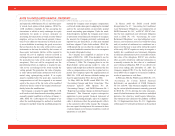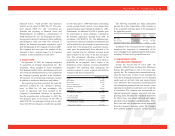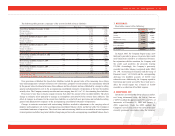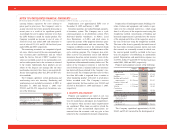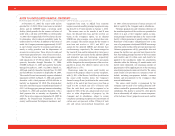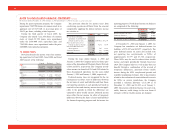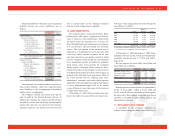Advance Auto Parts 2005 Annual Report Download - page 46
Download and view the complete annual report
Please find page 46 of the 2005 Advance Auto Parts annual report below. You can navigate through the pages in the report by either clicking on the pages listed below, or by using the keyword search tool below to find specific information within the annual report.
44
and supersedes APB Opinion No. 25 and subsequent-
ly issued stock option related guidance. SFAS No.
123R establishes standards for the accounting for
transactions in which an entity exchanges its equity
instruments for goods or services, primarily on
accounting for transactions in which an entity obtains
employee services in share-based payment transac-
tions. It also addresses transactions in which an enti-
ty incurs liabilities in exchange for goods or services
that are based on the fair value of the entity’s equity
instruments or that may be settled by the issuance of
those equity instruments. Entities will be required to
measure the cost of employee services received in
exchange for an award of equity instruments based on
the grant-date fair value of the award (with limited
exceptions). That cost will be recognized over the
period during which an employee is required to pro-
vide service in exchange for the award (usually the
vesting period). The grant-date fair value of employ-
ee share options and similar instruments will be esti-
mated using option-pricing models. If an equity
award is modified after the grant date, incremental
compensation cost will be recognized in an amount
equal to the excess of the fair value of the modified
award over the fair value of the original award imme-
diately before the modification.
The Company is required to apply SFAS No. 123R
to all stock or stock-based awards outstanding and sub-
sequently granted, modified or settled as of January 1,
2006. SFAS No. 123R requires the Company to use
either the modified-prospective method or modified-
retrospective method. Under the modified-prospective
method, the Company must recognize compensation
cost for all awards subsequent to adopting the standard
and for the unvested portion of previously granted
awards outstanding upon adoption. Under the modi-
fied-retrospective method, the Company must restate
its previously issued financial statements to recognize
the amounts the Company previously calculated and
reported on a pro forma basis, as if the prior standard
had been adopted. Under both methods, SFAS No.
123R permits the use of either the straight line or an
accelerated method to amortize the cost as an expense
for awards with graded vesting.
The Company has completed its analysis of the
impact of SFAS No. 123R. It has decided to use the
modified-prospective method of implementation as
of January 1, 2006. The Company plans to use the
Black-Scholes option pricing model to value all
options and straight-line method to amortize this fair
value as compensation cost over the required service
period. The Company expects the implementation of
SFAS No. 123R will decrease diluted earnings per
share by approximately $0.12 for fiscal 2006.
In May 2005 the FASB issued SFAS No. 154,
“Accounting Changes and Error Corrections.” This
statement replaces APB Opinion No. 20,
“Accounting Changes,” and FASB Statement No. 3
“Reporting Accounting Changes in Interim Financial
Statements.” This Statement requires retrospective
application to prior periods’ financial statements of
changes in accounting principle, unless it is impracti-
cable to determine either the period-specific effects
or the cumulative effect of the change. The Company
does not expect the adoption of this statement to have
a material impact on its financial condition, results of
operations or cash flows.
In March 2005 the FASB issued FASB
Interpretation No. 47, “Accounting for Conditional
Asset Retirement Obligations—an interpretation of
FASB Statement No. 143,” or FIN 47. FIN 47 clari-
fies the term conditional asset retirement obligation
used in SFAS No. 143, “Accounting for Asset
Retirement Obligations,” as a legal obligation to per-
form an asset retirement activity in which the timing
and (or) method of settlement are conditional on a
future event that may or may not be within the control
of the entity. FIN 47 requires an entity to recognize a
liability for a conditional asset retirement obligation
if sufficient information exists to reasonably estimate
fair value of the obligation. FIN 47 also clarifies
when an entity would have sufficient information to
reasonably estimate the fair value of a conditional
asset retirement obligation. FIN 47 was effective for
fiscal years ending after December 15, 2005. The
Company adopted FIN 47 in the fourth quarter of
fiscal 2005 with no impact to its financial condition,
results of operations or cash flows.
In February 2006 the FASB issued SFAS No. 155,
“Accounting for Certain Hybrid Financial
Instruments—an amendment of FASB Statements
No. 133 and 140.” This statement simplifies account-
ing for certain hybrid instruments currently governed
by SFAS No. 133 by allowing fair value remeasure-
ment of hybrid instruments that contain an embedded
derivative that otherwise would require bifurcation.
This statement also eliminates the guidance in SFAS
No. 133 Implementation Issue No. D1, “Application
of Statement 133 to Beneficial Interests in Securitized
NOTES TO CONSOLIDATED FINANCIAL STATEMENTS
(continued)
For the Years Ended December 31, 2005, January 1, 2005 and January 3, 2004 (in thousands, except per share data)


